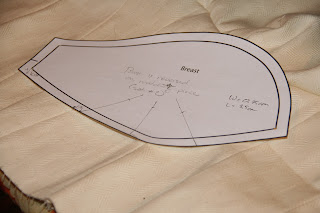As far as boning channels go and this corset, I'm planning to put them along each seam. It'll add a lot of interest with heavier contrasting thread as well as support. I also decided to put a channel up under the breast so hopefully I won't have to deal with finding a bridal bra. Corset and bra all in one! At right sewing the channel and below the finished result. I purposely only sewed this into the sandwiched layers. I didn't want this tunnel and stitching to show up on the taffeta part of the corset.

Next, after basting the taffeta layer on top of the other two, time to sew all the remaining channels. There are going to be 9 in all!
Darn! Something is wrong with my machine! After I'd sewn two channels the thread started totally bunching up on the back side and I almost broke a needle! Luckily I was using a practice piece of fabric when the machine went on the fritz. First thing in the morning off to find a sewing machine consultant!!! Booooo!
Noooooo! While I was busy sewing my puppy was busy making more work for me :(
 I was sure it was her and not my boxer, even though he was sleeping on top of the mess! She had feathers on her sweet little nose!
I was sure it was her and not my boxer, even though he was sleeping on top of the mess! She had feathers on her sweet little nose!




























